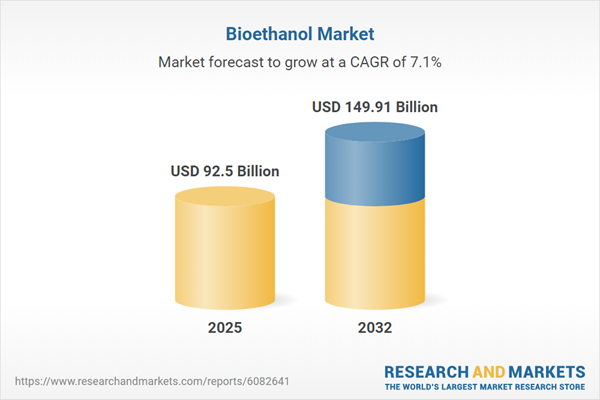Speak directly to the analyst to clarify any post sales queries you may have.
The bioethanol market is rapidly evolving as technology, regulation, and sustainability pressures drive fundamental shifts in value creation and operational models. Senior decision-makers need actionable insights to proactively adjust strategies within this dynamic sector.
Market Snapshot: Bioethanol Market Size and Growth
The global bioethanol market expanded from USD 86.74 billion in 2024 to USD 92.50 billion in 2025. Projected to achieve a compound annual growth rate (CAGR) of 7.07%, the sector is expected to reach a value of USD 149.91 billion by 2032. Growth is underpinned by heightened regulatory mandates, ongoing advancements in renewable fuel technologies, and broadening demand across newly emerging end-use applications beyond traditional fuel markets.
Bioethanol Market Scope & Segmentation
- Feedstock: Sourcing spans corn, sorghum, sugar beet, sugarcane, wheat, agricultural residues, algae-based resources, lignocellulosic biomass, as well as natural gas and oil. This diversity supports flexible production models and regional scalability.
- Production Technology: Key technologies include enzymatic hydrolysis, fermentation, gasification, and synthetic biology. Each enables improved conversion efficiencies, customization for industrial requirements, and the development of specialized product streams.
- Blending Type: Principal blends such as E10, E100, E15, E5, and E85 are selected depending on local regulatory environments, emissions targets, and compatibility requirements of regional vehicle fleets.
- Grade: Both fuel grade and industrial grade bioethanol address the distinct needs of energy, industrial, chemical, and pharmaceutical sectors for quality and application specificity.
- Distribution Channel: Bioethanol is distributed through established offline networks and increasingly through digital platforms, improving accessibility for both conventional and emerging buyers in the sector.
- End-use: Chemicals and petrochemicals, cosmetics, energy and power, food and beverage, household goods, industrial processing, pharmaceuticals, and transportation are the key consuming industries, each introducing unique product and regulatory requirements driving technological innovation.
- Regional Coverage: The sector operates globally, spanning the Americas, Europe, Middle East and Africa, and Asia-Pacific. Key markets include the United States, Brazil, Germany, China, India, and Australia, among others, highlighting the importance of regional policy landscapes and localized crop outputs in influencing supply chains.
- Company Profiles: Leading organizations such as Archer Daniels Midland Company, BP p.l.c., Abengoa Bioenergía, S.A., Alto Ingredients, Inc., British Sugar plc, Green Plains Inc., POET LLC, Valero Energy Corporation, and Wilmar International Limited—along with many others—play pivotal roles in technology investment, supply diversification, and vertical integration in the global bioethanol value chain.
Key Takeaways for Senior Decision-Makers
- Emerging production pathways are transforming market positions as companies adapt to evolving regulatory contexts and specialty opportunities in adjacent markets like pharmaceuticals and chemicals.
- Sustainability, with a growing focus on lifecycle emissions, now sits at the heart of operations and supply chain management, intensifying the drive for global transparency and accountability.
- Vertical integration—from raw material procurement through diversified output streams—enables robust risk management and stabilization of margins even as competitive pressures grow.
- Strategic partnerships and targeted technology investments are increasingly crucial, facilitating scale, managing capital risk, and accelerating innovation by leveraging specialized knowledge and resources.
- Cross-regional variations in resource access, policy frameworks, and infrastructure maturity necessitate highly localized market-entry and go-to-market strategies for all industry participants.
Tariff Impact: US Measures Reshaping the Bioethanol Value Chain
Recent United States tariff changes have prompted significant adjustments in global bioethanol trade. Companies are actively revising trading relationships, renegotiating contract terms, and shifting procurement strategies to safeguard competitiveness. These adjustments are stimulating investments in local processing infrastructure and encouraging the rise of new export hubs, making diversification in both buyer and supplier portfolios even more critical as the landscape evolves.
Research Methodology & Data Sources
This analysis is based on direct interviews, expert workshops, and technical validation from subject matter authorities. It draws on a comprehensive review of peer-reviewed literature and company disclosures, with scenario testing and triangulation to deliver reliable and actionable insights on the bioethanol sector.
Why This Report Matters
- Enables strategic investment planning by aligning organizational priorities with evolving regulatory demands, technical advances, and emerging trends across the bioethanol market.
- Supports well-informed decisions on feedstock selection, production methods, and technology adoption through detailed segmentation insight, fostering effective risk management and opportunity identification.
- Guides the optimization of supply chains and partnerships within a complex operational and regulatory environment, meeting the needs of global industry leaders.
Conclusion
Ongoing adaptation to feedstock innovation, technology upgrades, and sustainability demands is crucial for sustained leadership in bioethanol. Targeted, actionable insights empower senior executives to future-proof their strategies and effectively manage sector risks and opportunities.
Table of Contents
3. Executive Summary
4. Market Overview
7. Cumulative Impact of Artificial Intelligence 2025
Companies Mentioned
The companies profiled in this Bioethanol market report include:- Archer Daniels Midland Company
- BP p.l.c.
- Abengoa Bioenergía, S.A.
- Alcogroup S.A.
- Alto Ingredients, Inc.
- Atvos Bioenergia Brenco S.A.
- Bajaj Hindusthan Sugar Limited
- Balrampur Chini Mills Limited
- British Sugar PLC
- Clariant AG
- Cosan Limited
- Cristal Union Group
- CropEnergies AG
- FS Bioenergia
- GranBio Investimentos S.A.
- Green Plains Inc.
- INEOS AG
- Koch, Inc.
- Leaf by Lesaffre
- Pannonia Bio Zrt.
- POET LLC
- Praj Industries Limited
- Sekab Biofuels & Chemicals AB
- Tereos Group
- The Andersons, Inc.
- TruAlt Bioenergy Limited
- Valero Energy Corporation
- Verbio SE
- Vivergo Fuels Limited
- White Energy Inc.
- Wilmar International Limited
Table Information
| Report Attribute | Details |
|---|---|
| No. of Pages | 181 |
| Published | November 2025 |
| Forecast Period | 2025 - 2032 |
| Estimated Market Value ( USD | $ 92.5 Billion |
| Forecasted Market Value ( USD | $ 149.91 Billion |
| Compound Annual Growth Rate | 7.0% |
| Regions Covered | Global |
| No. of Companies Mentioned | 32 |









